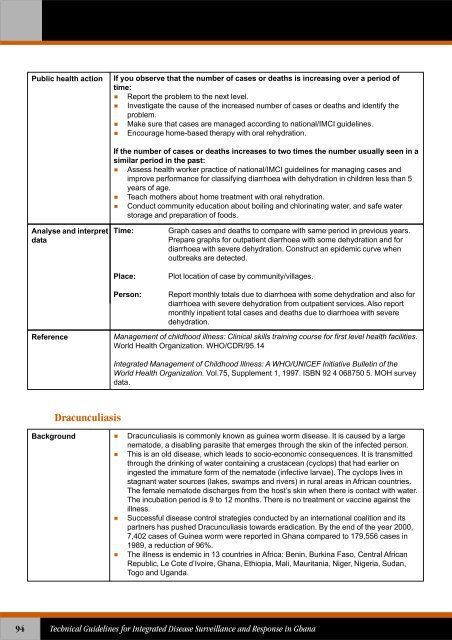Technical Guidelines for Integrated Disease Surveillance ... - PHRplus
Technical Guidelines for Integrated Disease Surveillance ... - PHRplus
Technical Guidelines for Integrated Disease Surveillance ... - PHRplus
You also want an ePaper? Increase the reach of your titles
YUMPU automatically turns print PDFs into web optimized ePapers that Google loves.
Public health actionIf you observe that the number of cases or deaths is increasing over a period oftime: Report the problem to the next level. Investigate the cause of the increased number of cases or deaths and identify theproblem. Make sure that cases are managed according to national/IMCI guidelines.Encourage home-based therapy with oral rehydration.If the number of cases or deaths increases to two times the number usually seen in asimilar period in the past: Assess health worker practice of national/IMCI guidelines <strong>for</strong> managing cases andimprove per<strong>for</strong>mance <strong>for</strong> classifying diarrhoea with dehydration in children less than 5years of age. Teach mothers about home treatment with oral rehydration. Conduct community education about boiling and chlorinating water, and safe waterstorage and preparation of foods.Analyse and interpretdataTime:Place:Person:Graph cases and deaths to compare with same period in previous years.Prepare graphs <strong>for</strong> outpatient diarrhoea with some dehydration and <strong>for</strong>diarrhoea with severe dehydration. Construct an epidemic curve whenoutbreaks are detected.Plot location of case by community/villages.Report monthly totals due to diarrhoea with some dehydration and also <strong>for</strong>diarrhoea with severe dehydration from outpatient services. Also reportmonthly inpatient total cases and deaths due to diarrhoea with severedehydration.ReferenceManagement of childhood illness: Clinical skills training course <strong>for</strong> first level health facilities.World Health Organization. WHO/CDR/95.14<strong>Integrated</strong> Management of Childhood Illness: A WHO/UNICEF Initiative Bulletin of theWorld Health Organization. Vol.75, Supplement 1, 1997. ISBN 92 4 068750 5. MOH surveydata.DracunculiasisBackground Dracunculiasis is commonly known as guinea worm disease. It is caused by a largenematode, a disabling parasite that emerges through the skin of the infected person. This is an old disease, which leads to socio-economic consequences. It is transmittedthrough the drinking of water containing a crustacean (cyclops) that had earlier oningested the immature <strong>for</strong>m of the nematode (infective larvae). The cyclops lives instagnant water sources (lakes, swamps and rivers) in rural areas in African countries.The female nematode discharges from the host’s skin when there is contact with water.The incubation period is 9 to 12 months. There is no treatment or vaccine against theillness. Successful disease control strategies conducted by an international coalition and itspartners has pushed Dracunculiasis towards eradication. By the end of the year 2000,7,402 cases of Guinea worm were reported in Ghana compared to 179,556 cases in1989, a reduction of 96%. The illness is endemic in 13 countries in Africa: Benin, Burkina Faso, Central AfricanRepublic, Le Cote d’Ivoire, Ghana, Ethiopia, Mali, Mauritania, Niger, Nigeria, Sudan,Togo and Uganda.94<strong>Technical</strong> <strong>Guidelines</strong> <strong>for</strong> <strong>Integrated</strong> <strong>Disease</strong> <strong>Surveillance</strong> and Response in Ghana















